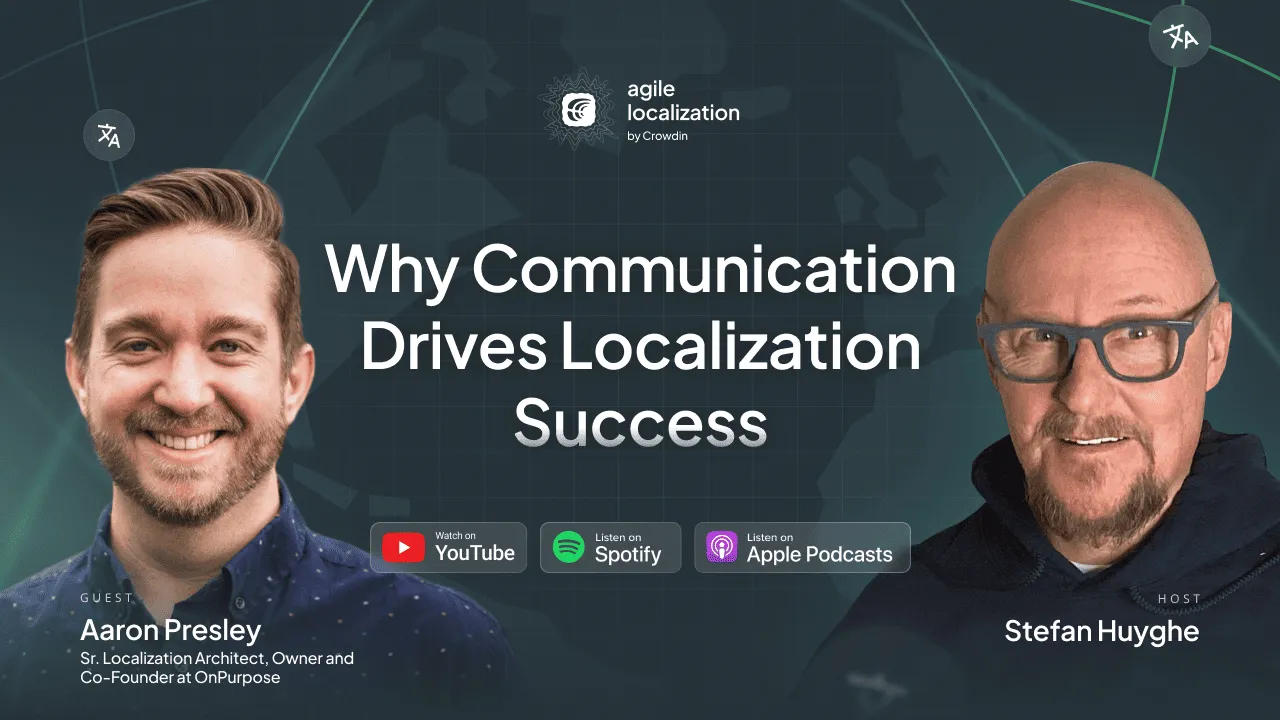When you think about global brands like Nike, it’s easy to assume they’ve mastered the art of localization. After all, they have massive budgets, teams spread across continents, and every technical tool you can imagine. However, as Aaron Presley, Co-founder and Sr. Localization Architect at OnPurpose Studio, reveals in this episode of The Agile Localization Podcast, even the biggest brands get some foundational things wrong about how they localize their content and systems.
In this wide-ranging conversation with host Stefan Huyghe, Aaron unpacks what makes or breaks a localization program, why it’s rarely about the tools themselves, and why the real challenge lies in bridging the communication gap between developers and localization teams.
Listen to the new episode on:
Developers vs. Localization Teams
Aaron’s journey into the world of localization is unusual. He started as a software engineer, fell in love with the messy nuances of language. Now he spends his time helping companies build scalable localization architectures. This gives him a unique perspective on why so many teams struggle to make localization truly agile.
One big issue? Engineers and localization professionals often talk past each other. Developers are wired to optimize for technical efficiency, while localization teams think in terms of linguistic nuance.
Code is a black and white thing. Human language is not black and white.
This disconnect can lead to fragile systems that break when you try to expand into new markets. For example, Aaron explains how a common misstep can make life miserable down the road.
The Pitfalls of Legacy CMS and TMS Integrations
When Stefan asks why so many enterprise localization teams hit roadblocks integrating big CMS platforms with translation management systems, Aaron doesn’t hold back. He says the problem usually isn’t the tech; it’s how teams approach it.
Getting approved for AEM integration, for example, is more about navigating bureaucracy than writing complex code. Once you’re through that gate, the technical part is relatively straightforward if you understand both worlds.
Aaron’s advice? Localization folks should get more familiar with how CMS platforms handle content, while engineers need to understand the real goals of the localization frameworks they’re plugging in.
What Big Brands Get Right and Where They Go Wrong
Having worked at Nike, Aaron saw firsthand how big brands build localization pipelines. He credits the brand’s robust internal processes and regional experts with teaching him how to respect linguistic nuance in code.
But even with all their structure, big brands can get bogged down by too much process.
"Large companies often create friction through unnecessary steps. They have the budget to get localization right, but sometimes they don’t realize how their own silos are fighting each other.
His solution? Better communication, not more layers of approval. So much friction happens when people think they’re working on the same problem but see it completely differently. The marketing team wants to nail brand voice, engineering wants to deploy fast, and localization wants to keep linguistic integrity. If they don’t sync up early, the system design suffers.
The Must-Have for Agile Localization
So, what does a truly agile localization setup look like? Aaron says it boils down to a few essentials:
- Continuous deployment: Non-technical people should be able to push translation updates without tapping a developer’s shoulder every time. Integrations like Crowdin’s GitHub sync make this simple.
- Human-in-the-loop reviews: AI translation is great, but it’s not the end-all. Some parts of your site, like high-visibility landing pages, still need human eyes to get the cultural context right.
- Smart system design: Your codebase should be flexible enough to handle new locales and language variants without major surgery.
- Open lines of communication: Engineers and localization teams need to work from the same blueprint. It’s not about the tools; it’s about the team wielding them correctly.
Final Thoughts From Aaron
One reason clients trust Aaron and his team at OnPurpose Studio is that they bridge the divide between code and culture. If there’s one takeaway for big brands, it’s this: system design is only as strong as the conversations behind it. Get your teams aligned, build with the right mindset from the start, and you’ll save yourself countless headaches down the road.
Aaron’s Background
Aaron Presley is the Co-founder, Owner, and Sr. Localization Architect at OnPurpose Studio, where he specializes in helping companies optimize their localization tech stack and development processes. With a strong background in software engineering, including significant experience at Nike’s globalization team, Aaron brings a unique perspective that bridges the gap between technical development and localization needs. His expertise spans complex integrations, including the recent development of an Adobe Experience Manager connector for Crowdin, demonstrating his ability to solve enterprise-level localization challenges.
Listen to the new episode on:
Localize your product with Crowdin
Yuliia Makarenko
Yuliia Makarenko is a marketing specialist with over a decade of experience, and she’s all about creating content that readers will love. She’s a pro at using her skills in SEO, research, and data analysis to write useful content. When she’s not diving into content creation, you can find her reading a good thriller, practicing some yoga, or simply enjoying playtime with her little one.
